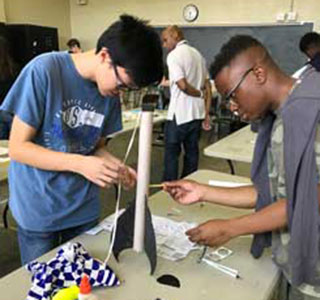Earlier this summer, more than 20 high school students got a taste of college and a strong dose of engineering knowledge during the 2017 UAB Materials Camp.
The camp, now in its seventh year, is led by Amber Genau, Ph.D., and it makes up the educational component of her CAREER grant, which was awarded last year. She collaborated with UAB’s Center for Community Outreach Development to identify a diverse group of capable students who will be entering 10th, 11th, or 12th grade this fall.
“One of my goals in working with CORD was to use their strong relationships with the underserved Birmingham City Schools to recruit more minority students,” Genau said. The end result was a diverse group of 22 total students from 17 high schools. The students worked in groups of three or four on a variety of engineering projects.
“As in past years, the main project activity was the design, building, and testing of a model rocket,” Genau said. “The teams learned about some of the engineering considerations for a successful rocket, then created the materials for their rockets themselves: high-tech carbon or fiberglass composites for the fins and 3D printing the nosecones.”
The finished rockets were judged at a launch on the West Campus Field. Judges selected a winner based on maximum height, simulated cost, appearance and performance. The winner was announced during a barbecue lunch provided for campers, families, and volunteers. This year’s winning rocket, “Iron Man” was built by Christian Hill (Helena HS), Sebastian York (Dora HS) and Alec Johnston (Mountain Brook HS), and sailed nearly 400 feet into the air.
Other activities during the week included a field trip to ACIPCO (led by Lindsay Hamner, a UAB materials engineering graduate who helped run the first UAB Materials Camp in 2011), a guest speaker from industry (Randy Kirkland, UAB alum and senior metallurgist for Hanna Steel), and a panel discussion with current UAB students. The camp also included several tours of campus labs and many hands-on activities. One morning, students rotated through four research labs, performing different activities in each one under the supervision of MSE professors and graduate students. Another activity that students particularly enjoyed was Disassembly Discovery: a group activity in which students were given small electronic devices (toaster, portable TV, handheld vacuum, etc.) and screw drivers, and tasked with disassembling these items into as many separate components as possible while considering the different types of materials used in their device (metal, plastic, ceramic, or composite).
In the Balloon Skewer Relay Race, shown in the above video, participants race to see which team can skewer the most balloons without popping them. "Normally, if you poke a balloon with a skewer, it will pop," says Genau. "But thanks to the unique molecular structure of the polymers, a little bit of liquid dish soap will allow the skewer to slip through the plastic without breaking it. Of course, this requires a soft touch."
Parents or high school students interested in attending a future Materials Camp can find more information after the first of the year at the camp web site.
